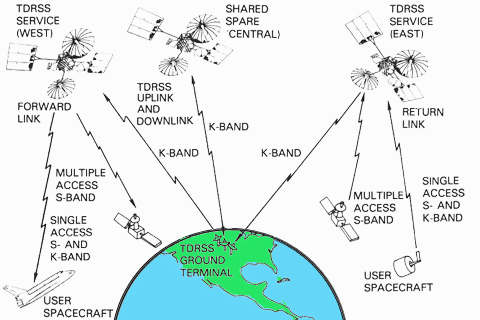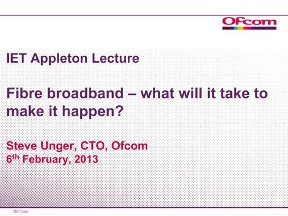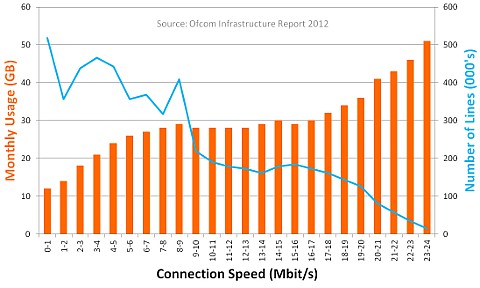For those who have not yet seen the Oscar winning film, Gravity, please note that although there are no spoilers (in the traditional sense) in the ensuing text, for those who are regular readers of Wireless Waffle, reading what is to follow before seeing the film may leave you with the same level of bemused bewilderment that it did us, and may spoil your enjoyment of the film! So a spoiler that's not a spoiler.
The movie begins with a few astronauts on a space-walk (a.k.a EVA) to add some new equipment to the Hubble space telescope. They are communicating with each other using radios built into their space suits and also, at the same time, are able to communicate seamlessly with ground control in Houston.
Following the 'disaster' around which the film's premise is based, the astronauts lose communication with Houston, and, for that matter, any ground based people. According to the film, this has been caused by the loss of the communication satellites that were handling the signals. In addition, their space suit radios seem incapable of communicating with each other over ranges of just a few hundred metres.
Let's first examine the space suit radios themselves. According to a document provided by NASA the range of the communication system between suits is just 80 metres in the worst case (though could be much greater). Given that this system took US$20 million to develop and operates in a 'free space' environment, the poor coverage performance is lamentable. However, it appears that this element of the story might just be feasible. Note that the Russians use a much more off-the-shelf technology for EVA voice communication that has a much greater range!
Could a ground station communicate directly with a space-suit. Based on NASA's paper, and on typical UHF communication systems, no. But with a little ingenuity, for example the use of a high power transmitter and high gain antenna on the ground, it is not beyond the wit of man.
 As for a loss of Earth-space communication being caused by the loss of a communications satellite, there are satellites used to relay data from space to Earth (for example, the TDRSS), however full data communications with a space shuttle could also be accomplished directly from the shuttle to a network of ground stations at S-band frequencies around 2.2 GHz (and voice-only communication at VHF and UHF frequencies). Although in theory, these ground stations could be connected back to Houston via satellite, the chances are that there would be a terrestrial, fibre-based connection that could do the job just as well. So whilst passing over such a ground station, there is no reason why Earth-space communication could not have been re-established. Of course a space vehicle (such as the shuttle) is then needed to relay these signals to any astronauts on EVA.
As for a loss of Earth-space communication being caused by the loss of a communications satellite, there are satellites used to relay data from space to Earth (for example, the TDRSS), however full data communications with a space shuttle could also be accomplished directly from the shuttle to a network of ground stations at S-band frequencies around 2.2 GHz (and voice-only communication at VHF and UHF frequencies). Although in theory, these ground stations could be connected back to Houston via satellite, the chances are that there would be a terrestrial, fibre-based connection that could do the job just as well. So whilst passing over such a ground station, there is no reason why Earth-space communication could not have been re-established. Of course a space vehicle (such as the shuttle) is then needed to relay these signals to any astronauts on EVA.

There is then a moment when one of the astronauts finally receives a signal from the ground but it appears to be from a Chinese man whose dogs and baby can be heard to be barking and crying (respectively) over the air. Whilst tuning into these transmissions, the astronaut in question says 'you're coming in on an AM frequency'. What is an AM frequency when it's at home? AM is a modulation scheme and not a frequency. And why would someone sitting at home in China be using any kind of frequency that is shared with Earth-space communications? And the communication seems to be full duplex as the astronaut can communicate with the man on the ground concurrently with listening to his transmissions. None of this makes much sense.
 And lastly, communication with the ground is finally re-established when a landing module descends into the atmosphere. The range of the types of frequencies used for Earth-space communications at atmospheric altitudes is limited by the curvature of the earth, (e.g. at 30,000 feet, the range of communications is roughly 300 km). This would mean that those on the ground would have needed to be aware of the location where the landing module was coming down (odd that they could do this if they had had no communication with the landing module until that point) and thus be in the neighbourhood for communications to be possible.
And lastly, communication with the ground is finally re-established when a landing module descends into the atmosphere. The range of the types of frequencies used for Earth-space communications at atmospheric altitudes is limited by the curvature of the earth, (e.g. at 30,000 feet, the range of communications is roughly 300 km). This would mean that those on the ground would have needed to be aware of the location where the landing module was coming down (odd that they could do this if they had had no communication with the landing module until that point) and thus be in the neighbourhood for communications to be possible.
Whilst the film may have excelled for its special effects, the way in which the radio communications were portrayed will be a real 'spoiler' for anyone who knows anything about the radio technologies or radio propagation. Still, science-fiction, by its definition, doesn't need to be scientifically accurate!
The movie begins with a few astronauts on a space-walk (a.k.a EVA) to add some new equipment to the Hubble space telescope. They are communicating with each other using radios built into their space suits and also, at the same time, are able to communicate seamlessly with ground control in Houston.
Following the 'disaster' around which the film's premise is based, the astronauts lose communication with Houston, and, for that matter, any ground based people. According to the film, this has been caused by the loss of the communication satellites that were handling the signals. In addition, their space suit radios seem incapable of communicating with each other over ranges of just a few hundred metres.
Let's first examine the space suit radios themselves. According to a document provided by NASA the range of the communication system between suits is just 80 metres in the worst case (though could be much greater). Given that this system took US$20 million to develop and operates in a 'free space' environment, the poor coverage performance is lamentable. However, it appears that this element of the story might just be feasible. Note that the Russians use a much more off-the-shelf technology for EVA voice communication that has a much greater range!
Could a ground station communicate directly with a space-suit. Based on NASA's paper, and on typical UHF communication systems, no. But with a little ingenuity, for example the use of a high power transmitter and high gain antenna on the ground, it is not beyond the wit of man.
 As for a loss of Earth-space communication being caused by the loss of a communications satellite, there are satellites used to relay data from space to Earth (for example, the TDRSS), however full data communications with a space shuttle could also be accomplished directly from the shuttle to a network of ground stations at S-band frequencies around 2.2 GHz (and voice-only communication at VHF and UHF frequencies). Although in theory, these ground stations could be connected back to Houston via satellite, the chances are that there would be a terrestrial, fibre-based connection that could do the job just as well. So whilst passing over such a ground station, there is no reason why Earth-space communication could not have been re-established. Of course a space vehicle (such as the shuttle) is then needed to relay these signals to any astronauts on EVA.
As for a loss of Earth-space communication being caused by the loss of a communications satellite, there are satellites used to relay data from space to Earth (for example, the TDRSS), however full data communications with a space shuttle could also be accomplished directly from the shuttle to a network of ground stations at S-band frequencies around 2.2 GHz (and voice-only communication at VHF and UHF frequencies). Although in theory, these ground stations could be connected back to Houston via satellite, the chances are that there would be a terrestrial, fibre-based connection that could do the job just as well. So whilst passing over such a ground station, there is no reason why Earth-space communication could not have been re-established. Of course a space vehicle (such as the shuttle) is then needed to relay these signals to any astronauts on EVA.
There is then a moment when one of the astronauts finally receives a signal from the ground but it appears to be from a Chinese man whose dogs and baby can be heard to be barking and crying (respectively) over the air. Whilst tuning into these transmissions, the astronaut in question says 'you're coming in on an AM frequency'. What is an AM frequency when it's at home? AM is a modulation scheme and not a frequency. And why would someone sitting at home in China be using any kind of frequency that is shared with Earth-space communications? And the communication seems to be full duplex as the astronaut can communicate with the man on the ground concurrently with listening to his transmissions. None of this makes much sense.
 And lastly, communication with the ground is finally re-established when a landing module descends into the atmosphere. The range of the types of frequencies used for Earth-space communications at atmospheric altitudes is limited by the curvature of the earth, (e.g. at 30,000 feet, the range of communications is roughly 300 km). This would mean that those on the ground would have needed to be aware of the location where the landing module was coming down (odd that they could do this if they had had no communication with the landing module until that point) and thus be in the neighbourhood for communications to be possible.
And lastly, communication with the ground is finally re-established when a landing module descends into the atmosphere. The range of the types of frequencies used for Earth-space communications at atmospheric altitudes is limited by the curvature of the earth, (e.g. at 30,000 feet, the range of communications is roughly 300 km). This would mean that those on the ground would have needed to be aware of the location where the landing module was coming down (odd that they could do this if they had had no communication with the landing module until that point) and thus be in the neighbourhood for communications to be possible.Whilst the film may have excelled for its special effects, the way in which the radio communications were portrayed will be a real 'spoiler' for anyone who knows anything about the radio technologies or radio propagation. Still, science-fiction, by its definition, doesn't need to be scientifically accurate!
add comment
( 570 views )
| permalink
| 



 ( 2.7 / 1521 )
( 2.7 / 1521 )




 ( 2.7 / 1521 )
( 2.7 / 1521 )
Tuesday 11 February, 2014, 19:09 - Much Ado About Nothing
Posted by Administrator
Given the current extreme weather battering the UK, the time seemed very apt to give a plug to an excellent novel whose plot-line is chillingly familiar.Posted by Administrator
 Flood by British hard-fiction author Stephen Baxter begins with the River Thames flooding in London and leads to a tale of global catastrophe. The follow-up, Ark, continues the story as the human race battles for survival.
Flood by British hard-fiction author Stephen Baxter begins with the River Thames flooding in London and leads to a tale of global catastrophe. The follow-up, Ark, continues the story as the human race battles for survival.The hard-fiction genre of books aim to use existing scientific theories but weave them into a piece of fiction. They're not about visits from aliens, or interstellar war, but instead focus on 'what might happen' by developing current scientific thinking. At the end of many stories, the author will divulge which bits of the book are real and which are made-up - and the bits that are real are often more incredulous than the fictitious bits.
If you have never read a science fiction book of any kind, Steven Baxter's books come highly recommended by Wireless Waffle and in many cases may not remain fiction for that much longer!
Friday 7 February, 2014, 13:43 - Broadcasting, Licensed, Much Ado About Nothing
Posted by Administrator
What a disappointment it was to find a recording called 90 years of the time pips, to discover that it is a special version of the pips¹ designed to celebrate their 90th birthday.Posted by Administrator
Wouldn't it have been more fun to have calculated how many pips there have been in 90 years and then created audio that just pipped (or beeped continuously) through all 90 years? How many pips would that be?
90 years × 365.25 days × 24 hours = 788,940 hours²
The first 5 pips have a duration of a tenth of a second, and the final pip has a duration of half a second, so the total duration of the pips each hour is exactly 1 second (5 × 0.1 + 0.5). A constant tone of duration 788,940 seconds (which is 9 days, 3 hours and 9 minutes precisely) would therefore represent '90 years of the time pips' much more accurately.
So here for your listening pleasure, is the Wireless Waffle tribute to the pips... 90 years of pips compressed into 9 days, 3 hours and 9 minutes.
 ¹ Not to be confused with Gladys Knight's backing group who, whilst also played on the BBC from time-to-time, are not the pips in question here.
¹ Not to be confused with Gladys Knight's backing group who, whilst also played on the BBC from time-to-time, are not the pips in question here.² Of course the pips have not been broadcast every hour over that period. Other time signals (such as the chimes of Big Ben) are used on some hours. Equally the BBC has not always been a 24 hour service, so this figure is probably a significant over-estimate.
Thursday 7 February, 2013, 13:15 - Much Ado About Nothing
Posted by Administrator
Posted by Administrator
 At the IET, Ofcom's chief technology officer, Steve Ungar, gave the annual IET Appleton lecture (parts of which can be viewed on the IET.tv web-site). The title of the lecture was 'Superfast Broadband - what will it take to make it happen', though the opening slide (shown on the right) suggested that Ofcom's views on superfast broadband are clearly that 'superfast equals fibre'. Whether or not wireless (eg LTE) or even satellite services could deliver superfast broadband was discussed in the question and answer session at the end of the presentation at which Dr Ungar indicated that, of course, both had a role to play. But the Freudian slip on the opening slide clearly shows in which direction Ofcom sees the future of high speed broadband.
At the IET, Ofcom's chief technology officer, Steve Ungar, gave the annual IET Appleton lecture (parts of which can be viewed on the IET.tv web-site). The title of the lecture was 'Superfast Broadband - what will it take to make it happen', though the opening slide (shown on the right) suggested that Ofcom's views on superfast broadband are clearly that 'superfast equals fibre'. Whether or not wireless (eg LTE) or even satellite services could deliver superfast broadband was discussed in the question and answer session at the end of the presentation at which Dr Ungar indicated that, of course, both had a role to play. But the Freudian slip on the opening slide clearly shows in which direction Ofcom sees the future of high speed broadband.This slip-up aside, one of the most interesting slides presented by Dr Ungar compared the connection speed that users enjoy with the amount of data they consumed. This diagram is reproduced below (the data is taken from Ofcom's 2012 Infrastructure Report. What it shows are some things that are obvious and others which maybe are not.

The obvious first:
- The chart shows that users with connection speeds of below around 5 Mbps do not consume as much data as those with faster connections. This is relatively obvious because the slower the connection, the lesser the ability to consume data. A user with a 1 Mbps connection would have to use their connection 5 times longer to download the same amount of data as a user with a 5 Mbps connection.
- The chart also shows that those who specifically elect to have a very high speed connection of over 16 Mbps consume more data than those with a slower connection. In effect, those who are paying for higher speed connections (which accounts for approximately 10% of all connections) are doing so because they actually want to use them.
What is not obvious and is quite surprising is that for those with connection speeds in the range of 6 to 16 Mbps, the amount of data they consume each month remains remarkably consistent (at around 28 Gbytes). Having a faster connection does not lead to using more Internet. It thus seems that there is a natural plateau of usage for an average user that is pretty consistent. And that plateau can be reached with a connection speed of 5 Mbps or greater.
Whilst the height of this plateau will inevitably rise as the number of connected devices in homes increases, it does suggest that, for today's British household, a connection speed of 5 Mbps or greater, with a data cap of 40 Gbytes per month (to allow for the occasional peak now and then) would satisfy around 90% of Internet users. Returning to the question of superfast broadband, it therefore seems somewhat gung-ho to be spending hundreds of millions of pounds investing in a fibre-based system which, even Dr Ungar admitted, would only ever reach around two-thirds of the population.
Terrestrial wireless networks (3G) can already deliver the kind of speeds required (HSPA+ offers connection speeds of up to 42 Mbps and even faster if MIMO antennas are used) and tariffs with unlimited data (subject to the usual fair use policies) can be had for around GBP20 per month. Even satellite broadband tariffs, often seen as uneconomical, can offer connection speeds of 20 Mbps with unlimited data download for around GBP35 per month. As things stand, both 3G and satellite networks can provide speeds and packages that exceed what Ofcom has shown to be the average requirement of a typical Internet user of today. As with all such technologies, as time progresses, they will improve and may well stay ahead of requirements.
 What Dr Ungar also pointed out was that the 'last few metres' of almost all Internet connections today are wireless, whether it is the few metres from the WiFi hub to the tablet, or from the cellular mast to the smartphone. To support the kinds of speeds likely to be necessary in the future, it is almost certain that fibre will be needed to deliver connections to wireless access points. In cities these are likely to be homes, streetlamps and anywhere else that a wireless hub can be located. Outside these areas, the availability of fibre will be sparse.
What Dr Ungar also pointed out was that the 'last few metres' of almost all Internet connections today are wireless, whether it is the few metres from the WiFi hub to the tablet, or from the cellular mast to the smartphone. To support the kinds of speeds likely to be necessary in the future, it is almost certain that fibre will be needed to deliver connections to wireless access points. In cities these are likely to be homes, streetlamps and anywhere else that a wireless hub can be located. Outside these areas, the availability of fibre will be sparse.But the good news is, that in rural areas, existing wireless technologies can already deliver the kinds of speeds and data packages that meet the needs of the everyday Internet user. The so-called digital divide between urban and rural areas can already be spanned using existing technologies and services (in fact even Ferrets can do it), all that's needed is for regulators to take a step back and recognise that superfast broadband is not always necessary and that, by association, fibre is not necessarily the solution to every ill. A more balanced investment strategy that takes into account the strengths and weaknesses of each of the possible Internet connectivity solutions, and levels the playing field between them, might yield much greater public satisfaction.


